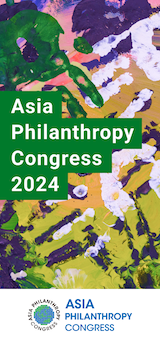In February, I was lucky to be among the 200 delegates from the fields of philanthropy and peacebuilding who were hosted in Belfast by the Social Change Initiative. Over four days, we examined our era of spiralling conflict, and asked how philanthropy could make a difference. The entire conference had two ever-present realities that were acknowledged so often that they may as well have been the event’s subtitle.
The first was October 7th and the ongoing Israel-Gaza war, then in its fifth month (though already having produced 4/5ths of the total death toll we’ve seen to date). The horror and human tragedy were inescapable. The second was all around us, too, in that we were in Belfast – site of the most successful exercise in international conflict resolution in recent memory.
As an Irishman who came of age during the Good Friday era, and who has worked on peacebuilding in Israel-Palestine for most of the time since, one would expect me to be in my element there. Yet, with the stakes in the Middle East so high, the bleak contrast with the progress in Northern Ireland proved illuminating but also frustrating.
Alliance magazine, which played an active role in the Belfast event, recently published a series of articles from across Jewish and Israeli and Palestinian philanthropy respectively. The ten articles highlight the complex philanthropic dynamics at play during this war but left me wondering: Why is it that philanthropy was so effectively marshalled toward conflict resolution in Northern Ireland. Yet funds flowing to Israel and Palestine – which are orders of magnitude greater in size – disproportionately support priorities that either ignore, sustain or deepen the conflict?
We know that activities that work toward inter-group engagement and the disruption of ethnic and physical separation played an outsized role in conflict resolution in Northern Ireland, as well as in other conflict zones. So why do such initiatives constitute a rounding error in overall investment in Israel-Palestine? Why, according to research conducted by Nadav Bigelman, do ‘liberal organisations’ (of whom peacebuilding is a mere subset) constitute just 30% of the overall budget devoted to socio-political change within in Israel? And why do people-to-people projects that bring Israelis and Palestinians together– and which often have waiting lists and are plagued by funding crises– only represent 5 percent of that very same investment? Why is this work not better prioritised by governments, funders and local gatekeepers?
Since the outbreak of war, philanthropic efforts understandably have focused heavily on immediate humanitarian needs. Jewish and Israeli philanthropists responded swiftly to the October 7th massacre, with over $2 billion being donated for Israel’s recovery efforts. Significant sums have been donated by Arab philanthropy and governments to address the humanitarian crisis in Gaza. Each of these priorities is worthy, and indeed essential. But neither is strategic nor transformative. They arguably constitute rescue investments made necessary due to the failed strategies that preceded them.
Sitting in Belfast, it was hard not to see the fruits of an alternative, more strategic approach. In Northern Ireland, philanthropists took the first bold steps that led to billions in investments in conflict resolution from both diaspora and international communities. Starting in the 1980s, Carnegie UK Trust, the Community Foundation for Northern Ireland, and the Joseph Rowntree Charitable Trust, contributed many tens of millions of dollars to initiatives that focused on education, human rights, and peacebuilding. Atlantic Philanthropies, led by billionaire Chuck Feeney, invested over $570 million in Northern Ireland peacebuilding efforts, including human rights, policing reform, integrated education, and economic development. These visionary philanthropies helped to trigger a change in Irish diaspora identity, inspiring many Irish Americans to follow suit and add their resources and political weight to conflict resolution.
On the heels of these new private funder and diaspora efforts, the US Congress followed suit. Already in the mid-1980s, it established the International Fund for Ireland (IFI) alongside multiple donors, ultimately enabling the fund to deliver and unlock over $2.4 billion in total peacebuilding investments. Jonathan Powell, Tony Blair’s Chief Negotiator in 1998, called the IFI ‘the great unsung hero’ of the Good Friday Agreement.
The IFI not only helped a delicate diplomatic process, but it also paved the way for another massive contribution. After starting as a partner in funding the IFI, the EU went on to establish its own EU PEACE vehicle, investing over €3.5 billion to help secure and sustain the gains made via diplomacy. This combination of private and governmental funding exponentially scaled the work of civil society. Combined with real and substantive diplomacy, it proved one of the most effective formulas we know of in ending violent conflict in the modern era. In Northern Ireland, the IFI impact alone amounted to at least $44 per person annually on this work for over three decades. In Israel-Palestine, the sums remain negligible
Instead, external philanthropy has been directing its resources in another direction. In the Middle East, hundreds of millions of dollars’ worth of private philanthropy have been invested in Israeli settlements over the last decade. A single academy in the West Bank churns out more alumni each year than most peacebuilding projects. Private funds from the Arab world and state actors flow toward not just social services but also the weapons that buttress Hamas and Hezbollah. It can be assumed that they also produce more alumni each year than peacebuilding organisations. And in a year where the US has sent more than $18 billion worth of weapons to the region, it is worth asking whether investments in mitigating the human fallout of the use of those weapons is enough? It’s time for a concurrent, ambitiously resourced strategy, to resolve rather than sustain conflict.
Luckily, there are signs that key governments are beginning to wake up to the failure of the strategies that led us here. First, the Alliance for Middle East Peace was proud to have led the advocacy that resulted in the passage of the Middle East Partnership for Peace Act (MEPPA), a bipartisan US law. That act now means an investment of $50 million per year in peacebuilding, roughly half toward civil society and half toward economic development. This past summer, the European Union’s Foreign Policy Instrument announced €20 million toward “civil society empowerment for peaceful coexistence” in Israel-Palestine. In June, G7 heads of government signed off on new policy language pledging for the first time to ‘work together—and with other international partners—to closely coordinate and institutionalise our support for civil society peacebuilding efforts.’
Where is liberal philanthropy?
Yet we are still to see private philanthropy – a leading innovator and catalyst, which moved before governments did in Northern Ireland – develop a collective strategy to work alongside and leverage these increasing governmental funding commitments. Private donors can tolerate greater risk than governments, they can move more speedily, and they can test and pioneer new techniques and approaches to be picked up and scaled by state funding. Today, there are real opportunities for philanthropy to leverage increased governmental support for peacebuilding some of which are articulated in a recent white paper.
There is no lack of ideas, nor of private philanthropic resources flowing into the region. Especially from diaspora communities who– as in Ireland– care deeply. It’s essential to now find a way to channel that concern toward priorities that address root causes rather than tragic outcomes. Philanthropy has the potential, and arguably the obligation, to open up civic space for conflict resolution.
The good news is that the Israeli-Palestinian civil society peacebuilding community is stronger, more strategic and more intensely networked than was the case in Northern Ireland when the IFI began its work in the late 1980s. Almost none of ALLMEP’s 160+ members have stopped their work since October 7th. In fact, over 25 percent have drastically increased activity, with activism and joint Israeli-Palestinian projects increasingly led by both Palestinians and Israelis who have paid the steepest price for continued conflict.
Since October 7th, organisations such as Standing Together have held together mixed cities in Israel, protected vulnerable communities, and gathered hundreds of trucks of aid for Gaza. The Parents Circle and Combatants for Peace have held a mass joint Israeli-Palestinian memorial day. Tech2Peace has trained and engaged hundreds of young Israelis and Palestinians. We at ALLMEP ran a deliberative AI-powered consultation project engaging hundreds of Israeli and Palestinian peacebuilders who aligned on a platform of shared values, as well as calls on their own governments and on world leaders. A coalition of more than a dozen ALLMEP members organised a peace event in July with more than 6,000 ticket-paying attendees. Every one of these projects, and many more besides, is based on Israeli-Palestinian partnership, and has the capacity to scale exponentially.
It is a moment when almost everything is malleable and in flux, allowing peacebuilders within civil society to play an outsized role in shaping what comes next. The longstanding fiction that the conflict could be ‘managed’ has entirely collapsed, with new ideas and fresh approaches liable to find newly awakened audiences. In short: it is a time where strategic philanthropy can have more long-term impact and return on investment. But first, it must make show courage. It should stop responding tactically to events and instead begin making the sort of investments that can shape a shared Israeli-Palestinian future.
John Lyndon is the executive director of the Alliance for Middle East Peace (ALLMEP).




Comments (0)